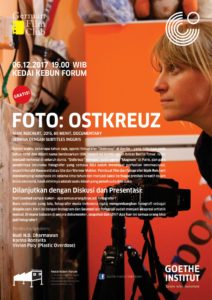

German Film Club
Cooperation between Kedai Kebun Forum (KKF) and Goethe Institut Jakarta
Wednesday, 6 December 2017, 7.00 pm
Auditorium, Kedai Kebun Forum (KKF)
Jl. Tirtodipuran 3, Yogyakarta
Open for public and free
presents
Photo: OSTKREUZ
Director: Maik Reichert, 2015, documentary, 80 min., German with English subtitles
– followed by discussion and presentation:
Art or documentation: Can everybody become a photographer?
Only little more than a decade ago, young Indonesian photographers started to develop photography as art form that now is also recognized by galleries and curators. Like once Ostkreuz they started taking pictures of daily life in streets or private homes that before would never have been considered worth to be shown to a public audience. Today everybody can experiment with photography on instagram and other social media. Where is the boundary between art and simply catching a moment? And what is the role of professional photographers in this new media world?
Speakers:
Budi N.D. Dharmawan
Karina Roosvita Indirasari
Vivien Poly
SYNOPSIS
The Berlin photographers’ agency “Ostkreuz” was founded in 1990. It was named after a railway junction in former East Berlin and became famous worldwide in just a few years. Its founding members – whose role model was the Parisian agency “Magnum” – was made up of photographers who had already achieved international recognition during the GDR era, such as Harald Hauswald and Ute and Werner Mahler. The filmmaker and photographer accompanied the group for about five years and witnessed artistic highlights and economic crises. The result is a tale of both success and woe.
At the start, Ute and Werner Mahler explain how they were both involved in the photographers’ agency “Ostkreuz” from the time it was first founded, and talk about the agency’s members and the work undertaken together. The number of prominent members has grown to such an extent in the meantime, that the couple find it hard to avoid omitting someone. Additionally, some of the photographs taken by the people mentioned are shown on screen. The photographs, which depict different themes, styles and focal points, already refer to a quality which becomes increasingly evident throughout the film: The members of “Ostkreuz” don’t only see their job as supposedly attractive or as something focusing solely on aesthetics – their work has always assumed a political, and even more so, an ethical stance. It all began with a European initiative. Jack Lang, the French Minister of Culture at the time, invited around 200 artists from the GDR to Paris in 1990, among which were numerous photographers. That’s where the idea of founding “Ostkreuz” first came to life. Its closeness to the legendary Parisian (and later international) “Magnum” agency was also a geographical one in this case.
Maik Reichert repeatedly observes the photographers on the job, especially the Mahler couple who work together. He accompanies them during the shooting of the portrait shots of the famous actors Nina Hoss and Lars Eidinger, for example. The combination of spontaneity and detailed staging they use on the job is fascinating. Werner Mahler has even designed a chair with a headrest that is not visible in the photos, but which positions the body upright. We see the young Julian Röder, who courageously takes snaps of some partly militant demonstrations against banks and globalisation. In 2010, he travelled to Seoul with his camera to cover the protests against the G20 summit. We learn about Harald Hauswald’s work. He took pictures of an illegal book presentation that took place in East Berlin’s Gethsemane Church during the GDR era, among other things. At some point, Hauswald worked as a telegram messenger in the district of Prenzlauer Berg. He was constantly on the go on his bike or on foot, and he always had his camera on him. For him, photography was a way of life, which at first represented, and not just for him, a social and poetic realism.
Maik Reichert shot over 100 hours of footage for his documentation. He also spent around 100 days accompanying the members of “Ostkreuz”. “I simply wanted to be present. Of course, it was a good thing I always filmed using a small camera and with a small team. To some extent, the same camera was used for two things at the same time: on the one hand, as a photo camera for OSTKREUZ, and on the other hand, as a film camera for me.” Maik Reichert shot a number of occasions: the developing process of the photos, the processing of the photos, the preparation of exhibitions and the discussions about the recent ever-increasing financial problems, which the members of “Ostkreuz” blame on the changing working conditions caused by the increasing pace of digital photography. Indeed, if you take a closer look, you’ll notice that the photographers still mainly use analogue equipment, including Ute and Werner Mahler’s old plate camera.
For more info please contact Uniph +6285725809139